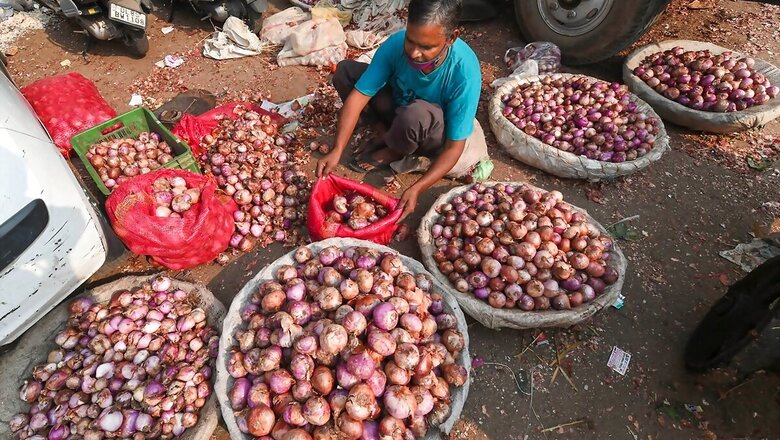
views
In order to prevent onion crisis this year, the central government is boosting the buffer stock of the kitchen staple by 100 percent. “We are building a buffer stock of 2 LMT this year- double of last year’s buffer size,” said Consumer Affairs Secretary Leena Nandan.
This buffer stock would be stored in a decentralized manner in the onion deficit areas so that they can be swiftly used to cool down prices through open disposal, Nandan added. The central government has already tied up in 12 locations across Maharashtra, Gujarat, Madhya Pradesh, and Delhi.
In September last year, onion prices spiked rapidly upto Rs 75 per kg in metropolitan cities like Mumbai and Chennai which led the central government to ban the export of the kitchen bulb to ensure availability in the domestic markets.
The government also went in for imports through the state-run MMTC. Indian High Commissioners in onion-growing countries had been alerted to facilitate imports, while the norms for imports were relaxed to facilitate imports by private players.
In 2020, by the third week of October, the price of the staple bulb had spiralled to Rs 86/kg in Mumbai, Rs 83/kg in Chennai, Rs 70/kg in Kolkata, and Rs 55/kg in Delhi. And in order to cool down retail prices, the central government had fallen back on its own buffer stock of one lakh metric tonnes for supplies to major markets yards across the country, retail outlets like SAFAL and Nafed, and also open sales.
The central government had offered the buffer stocks to states and union territories to boost availability at the procured rate of Rs 26/kg – Rs 28/kg to states who wanted to lift stocks on their own from Nashik and Rs 30/- for those who wanted it to be delivered.
Is the country looking at a possible price hike this year?
There are no easy answers. Secretary Consumer Affairs, Nandan said “the government keeps preparing for contingencies, what comes in the future cannot be predicted like that. We would deal with it with full force with any situation that arises.”
Shewta Saini, a senior fellow at the ICRIER says, “onion is a tricky explanation, at least as per my assessment this year. Overall, they are not expecting onion prices to rise immediately. Traders expect a bumper Rabi crop and assessment of Kharif is still rudimentary. Overall, because of base effect too, inflation year or year, may not be as high as last year.” However, there could be a catch as export orders pick up Saini points out, “onion exports were opened beginning January 1 this year. Price pressure in onion prices might feel upward pressure by June, when exports to neighbouring countries are expected to rise,” she added.
In the past two years, 2019-20 and 2020-21, the NDA government had to impose a minimum export price ( MEP ) to discourage exports followed by a complete ban on exports. In 2019-20, MEP was imposed effective from 13.09.2019, followed by a ban on onion exports with effect from 29.09.2019 after onion prices moved north. Both the MEP and ban on exports were lifted nearly five and half months later on 15.03.2020. Similarly, in 2020-21, the government banned onion exports again on September 14. Compared to the previous year, onions were banned for a period of three and half months, with the government lifting the same on January 1, 2021. While in 2018-19, the quantity of onions exported was 24.2 LMT, in 2019 -20, it was 11.5 LMT. In 2021, until March 14, exports had already touched 14 LMT.
The estimated total production of onions for 2021 is 262.92 LMT which is marginally higher compared to 260.91 LMT in 2019-20. However, if the production in each season were to be compared, there is a fluctuation – Kharif onion would be 37.38 LMT compared to 38.68 LMT last year, late Kharif onion- 30.95 LMT compared to 15.71 LMT last year, and Rabi onion – 205.69 LMT compared to 206.52 LMT.
Experts felt that the main reason for the high volatility in onion prices is the uncertainty of onion production in the Kharif season. Onion is grown in the country in three seasons, Kharif onion that is harvested between September and December, late Kharif that is harvested between January and March, and the Rabi onion, which is harvested between March and June.
The Kharif Onions account for 19% of the total onion production while late Kharif accounts for 10% and Rabi accounts for 71% of the total production. The leading Kharif onion-producing states are Karnataka, Maharashtra, Andhra Pradesh, Rajasthan, Madhya Pradesh, Tamil Nadu, and Gujarat while the leading Rabi onion producing states are Maharashtra, Madhya Pradesh, Rajasthan, Gujarat, and Bihar.
The cyclical stress that is felt in retail onion prices is usually because the Rabi season onion stocks begin to exhaust while the Kharif harvest is yet to hit the markets. There are other factors- unseasonal rains damaging production, cartelisation in the wholesale markets of Maharashtra, the leading onion producing state, hoarding, and more. However, there has to be a perception of possible stress in supplies for prices to spiral. Even though the price spiral follows a seasonal cycle, it has been a challenge for governments be it NDA or UPA to prevent or preempt high volatility in the retail price of the sensitive commodity. This year’s doubling of the buffer stock is one such preemptive step.
Read all the Latest News, Breaking News and Coronavirus News here


















Comments
0 comment